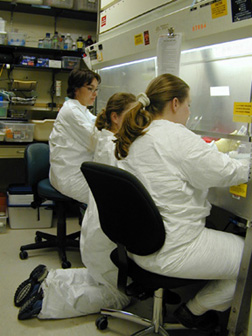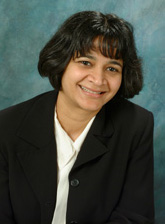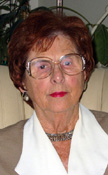One of the basic tenets of business is to turn a negative event into something positive.
In 1999-2000, UNMC was under siege from some politicians and religious groups for using fetal cell for research in an attempt to determine if brain cells could be regenerated in people with Alzheimer’s disease and other neurodegenerative disorders. Although many people agreed with what UNMC was trying to do, UNMC officials felt something needed to be done to show opponents UNMC was willing to do anything possible to reduce or eliminate the need to use fetal tissue.
 |
Research team leaders Dr. Raisa Persidsky, Spring Holter and Kathleen Borgmann perform rapid autopsy brain cell isolation in the laboratory on Oct. 31, 2001. |
The program received major acclaim this month when the Journal of Neuroimmunology carried two articles written by the UNMC RAP team. One article served as a tutorial for other institutions on what it takes to develop a RAP. The other article detailed the changes that occur in microglial brain cell function with HIV-1-associated dementia (HAD).
One of the scientific reviewers of the article hailed the program, writing: “This remarkable achievement is the first demonstration of the efficient acquisition of human brain tissue for cell culturing on a large-scale basis, and it demonstrates the feasibility of such practices. The manuscript is of high significance.(and) will be useful in guiding similar efforts at other institutions.”
 |
Anuja Ghorpade, Ph.D. |
Anuja Ghorpade, Ph.D., a CNND scientist who directs the program, was lead author for the two articles. She said: “When I was first ‘volunteered’ to head up the Rapid Autopsy Program, I had no idea of the time and manpower commitment that it would involve. It was a huge undertaking. But now, looking back after five years of doing rapid autopsies, it was well worth it.”
Since the RAP program began in April 2000, UNMC has conducted a total of 93 rapid autopsy procedures. Once the program was established, it has been averaging about two per month over the period of 2002-04. In addition, a total of 107 potential donation requests were screened.
“This has been an amazing team effort,” said Howard Gendelman, M.D., professor and chairman of the Department of Pharmacology and director of the CNND. “We knew it would take about $250,000 per year to run the program. With help from Chancellor (Harold M.) Maurer, President (L.Dennis) Smith, the Nebraska Legislature, the Board of Regents — Randy Ferlic in particular — and Governor (Mike) Johanns, we got this money for three years. We set the program up and eventually we got additional moneys from the National Institutes of Health and other sources.”
Dr. Gendelman said support of the UNMC staff has been “incredible.” He had special praise for several UNMC physicians, administrators and scientists – Sue Swindells, M.D., Jane Potter, M.D., Jennifer Larsen, M.D., and Ernie Prentice, Ph.D., who heads UNMC’s Institutional Review Board. He also cited Dr. Samuel Cohen’s team of pathologists, in particular Drs. Leslie Bruch and Rod McComb, “for stepping up to the plate to allow the impossible to happen in near record time.”
The RAP has been successful in obtaining two of the three cell types originally obtained from human fetal cells. The two cell types obtained are astrocytes and microglia. No functional neurons, the third cell type being studied at UNMC, have been obtained through the rapid autopsy procedure. Currently, no other medical center in the world has achieved this feat either.
Due to the success of the RAP, UNMC has been able to procure up to 95 percent of the microglia cells and 10 percent of the astrocytes required for its research. In doing so, UNMC has been able to reduce the quantity of fetal cell specimens it obtains from the Central Laboratory for Human Embryology at the University of Washington by about 40 percent.
The RAP includes three teams of scientists and technicians, including 20 members of the CNND. These individuals have undergone extensive training, Dr. Ghorpade said. On campus, the RAP coordinator, Betty Chin, meets regularly with several academic disciplines and patient care programs, including Pathology/Microbiology, Neonatal Intensive Care Unit, Adult Intensive Care Unit, Pastoral Care and Acute Bereavement Team.
|
|
“When you’re on call and a rapid autopsy opportunity becomes available, everything else in your life must be put on hold,” Dr. Ghorpade said. “It can be extremely disruptive. In the past we have performed rapid autopsy procedures on Halloween, Thanksgiving and other holidays. You never know when an opportunity will occur.
“It wouldn’t have been possible to build such a program without the unquestioned commitment of our research team leaders and other research personnel in my laboratory and the CNND. I really couldn’t have, and didn’t do it on my own, it was a team effort involving synchronization between research teams, program coordinators, pathologists, patient physicians, pathology assistants, the acute bereavement staff and last but not least, family members of the donors.”
Manya Nogg of Omaha is a huge supporter of the RAP. After reading a brochure on the RAP, she enrolled her mother, who had Alzheimer’s disease.
 |
Manya Nogg |
Nogg believes one way to increase the number of people in the donor pool would be to develop a video that could be shown to families with loved ones in the hospital or nursing home. “I was very impressed with the rapid autopsy brochure, but people don’t read as much today,” she said. “I think a video would be even more powerful.”
Nogg and her son, Randy, have developed a script for the video, and they’ve come up with a name for it – “The Gift of Life.” Now, they need to find funding. She estimates it would cost between $12,000 and $20,000, and she is contacting corporations and friends seeking donations.
“I tell people it’s the last opportunity for you and your loved one to do something meaningful — give the gift of life,” she said.
“The three real heroes are Dr. Anuja Ghorpade, the employees of UNMC and – most important – the donors and their families,” said Dr. Gendelman. “Anuja took the idea and translated it to reality. She made this happen with her intellect, her organizational skills and her abilities to persevere through even the toughest times. She is a glorious human being and people loved to support her. She got everyone working together.
“I can’t say enough about the UNMC employees who supported this effort. Whether they agreed or disagreed with the politics, they did what was right for the institution and for our state and its future as a leader in biomedical research. The donors and their families provided the greatest inspiration in supporting the program during life’s most difficult events. Watching all this unfold brought tears to my eyes.”
What others are saying about the Rapid Autopsy Program
Susan Swindells, M.D., professor and chair of HIV-AIDS research, Department of Internal Medicine, Infectious Disease Section — The RAP publications represent the culmination of an enormous amount of work. People from many and diverse UNMC and hospital areas came together to make this successful; sometimes this was their first time working together. The project also included wide representation from outside the medical center and would not have been possible without broad community support. Most importantly, Anuja Ghorpade and the rest of the core team devoted many hours, and even sleepless nights, to this endeavor. We proved that it was possible to develop a functional RAP, even though this is very labor-intensive. Tissues collected have been used in important scientific experiments, including the first study using brain tissue from a patient with HIV-associated dementia. We have learned a lot along the way, but none of it would have been possible without the incredibly generous contributions of the donors and their families. Personally, I was so often impressed by the willingness of our patients and their loved ones to participate in the program, even in times of great sadness.
Jane Potter, M.D., professor and chief of the section of geriatrics and gerontology — The RAP has provided an innovative approach to studying brain disorders in adults suffering from Alzheimer’s disease and related disorders. This program has made major advances in how to recover brain cells for study. The ability to isolate and study these cells opens the way for scientific understanding of the underlying disease processes and also the possibility of studying therapies that will one day allow us to treat and prevent these devastating disorders.
The Rev. Deborah Boucher-Payne, director, Pastoral Care & Patient Services, The Nebraska Medical Center — The RAP has offered hope and healing for so many people through the years. It has offered hope that there will be a cure for neurodegenerative disorders with such research being pursued. It also has offered some healing for the bereaved who have lost a loved one, yet donated so that others may have a better quality of life through the benefits of this research project. I have heard from many donor families what comfort they receive in knowing that their loved one will, in some way, help others in the future. So as this program gains national recognition, it affirms the donor families and their contribution to medical science, as well as promoting a research project that is invaluable in the answers that it is beginning to produce for the medical community.
Sam Cohen, M.D., Ph.D., professor and chairman, Department of Pathology & Microbiology — Development of the RAP is an incredible achievement, requiring outstanding organizational skills. The availability of fresh tissue for research is indispensable. The program developed at UNMC uniquely provides a resource for normal tissues and also tissues from individuals with a variety of diseases for direct comparison with the normal. The importance of such a resource is readily obvious from the large number of telephone calls and inquiries from individuals at other institutions asking for access to this material. Dr. Ghorpade and her colleagues are to be congratulated on this outstanding achievement.
Leslie Bruch, M.D., assistant professor, Department of Pathology & Microbiology — Creation of the RAP has provided an important resource for research on campus. Our program may serve as a model for development of other interdisciplinary programs, both at UNMC and at other institutions. It has been very rewarding to see the RAP come to fruition and to see our work receive national attention.